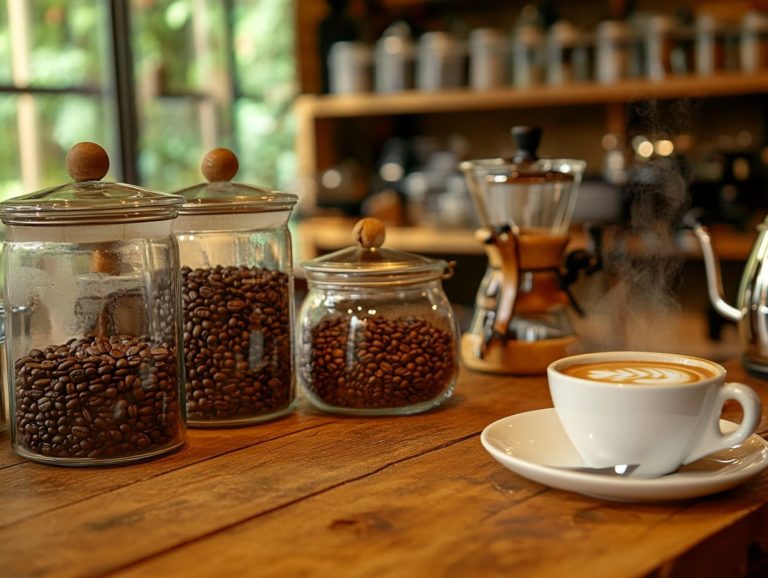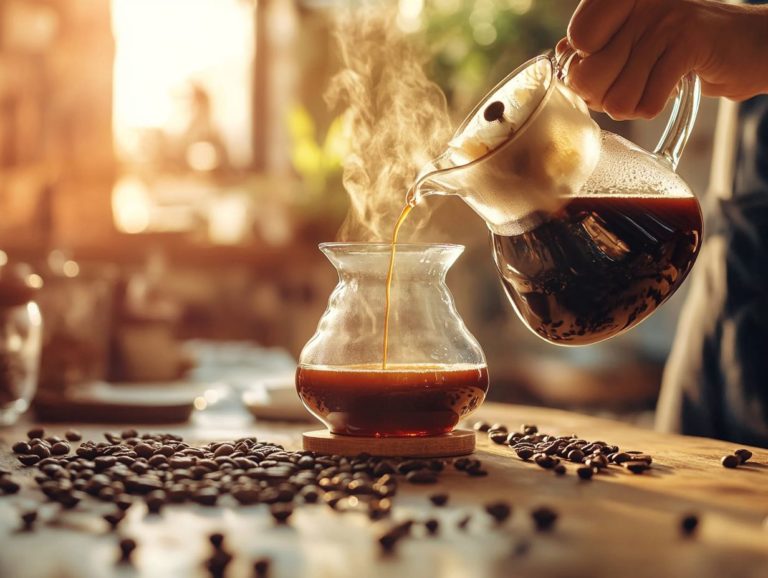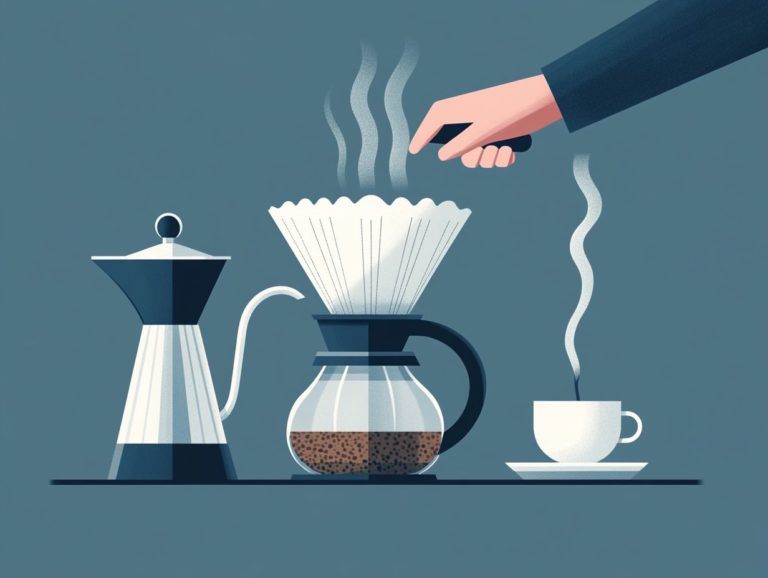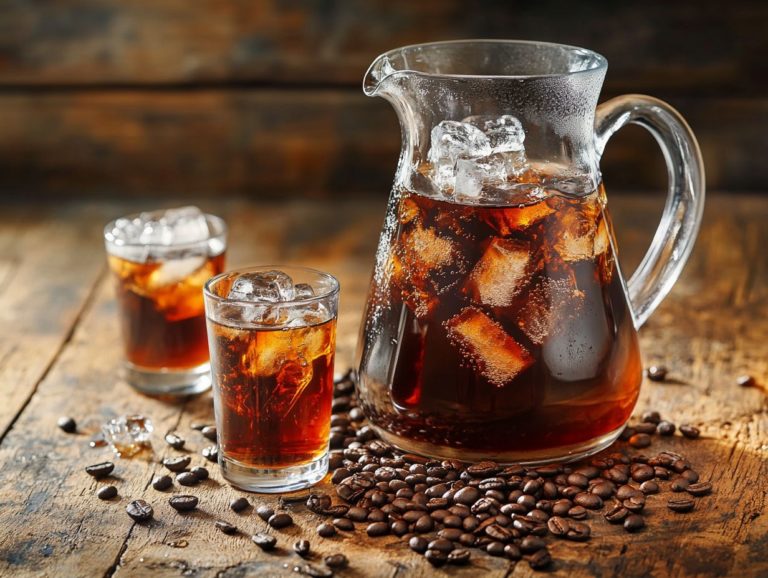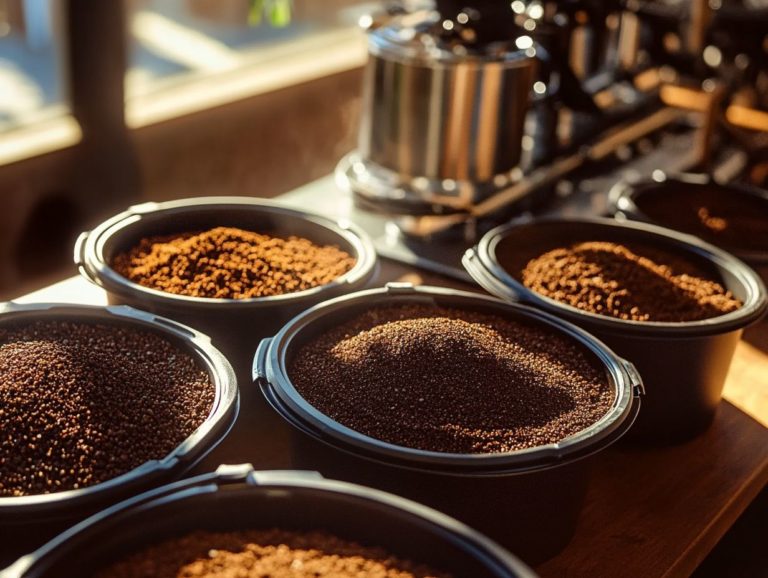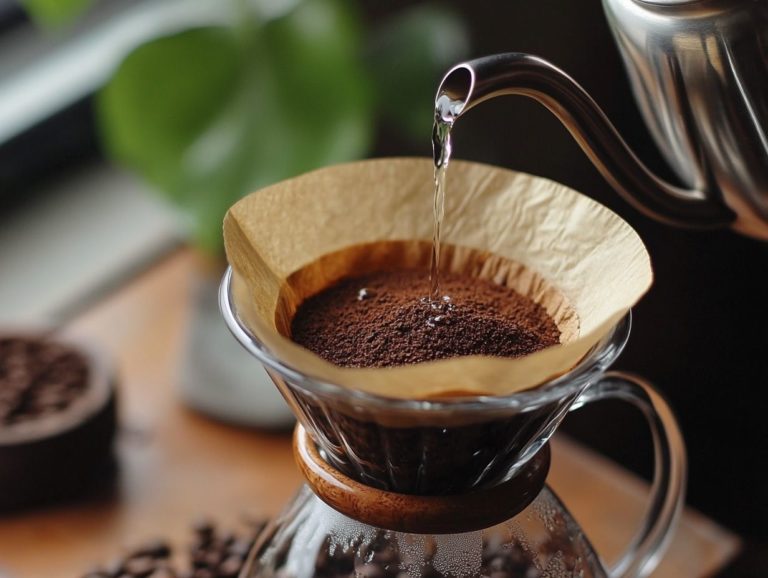Home Brewing: The Best Techniques for Flavor
Contents
- The Art of Home Brewing
- Key Takeaways:
- What is Home Brewing?
- Why Brew Beer at Home?
- What Equipment Do You Need for Home Brewing?
- What Ingredients Are Used in Home Brewing?
- What Are the Best Techniques for Flavor in Home Brewing?
- How to Choose the Right Ingredients for Your Desired Flavor?
- What Are the Different Methods of Adding Hops for Optimal Flavor?
- How to Control Fermentation for Optimal Flavor?
- What Are the Different Techniques for Adding Specialty Ingredients for Unique Flavors?
- How to Properly Age and Store Your Home Brew for Maximum Flavor?
- Frequently Asked Questions
- 6. How important is cleanliness in home brewing for flavor?
The Art of Home Brewing
Home brewing transcends mere hobby status; it is an art form that empowers you to craft unique flavors and experiment with your own brewing recipes. This guide presents the essentials of brewing beer at home, encompassing the myriad benefits, necessary brewing equipment, and key ingredients to start your brewing adventure.
Explore techniques to elevate flavor profiles, from choosing the ideal hops and yeast to mastering the nuances of fermentation and aging. Whether you are just starting out or aiming to refine your craft, this guide provides all the insights you need to brew exquisite beer right in your own kitchen.
Key Takeaways:
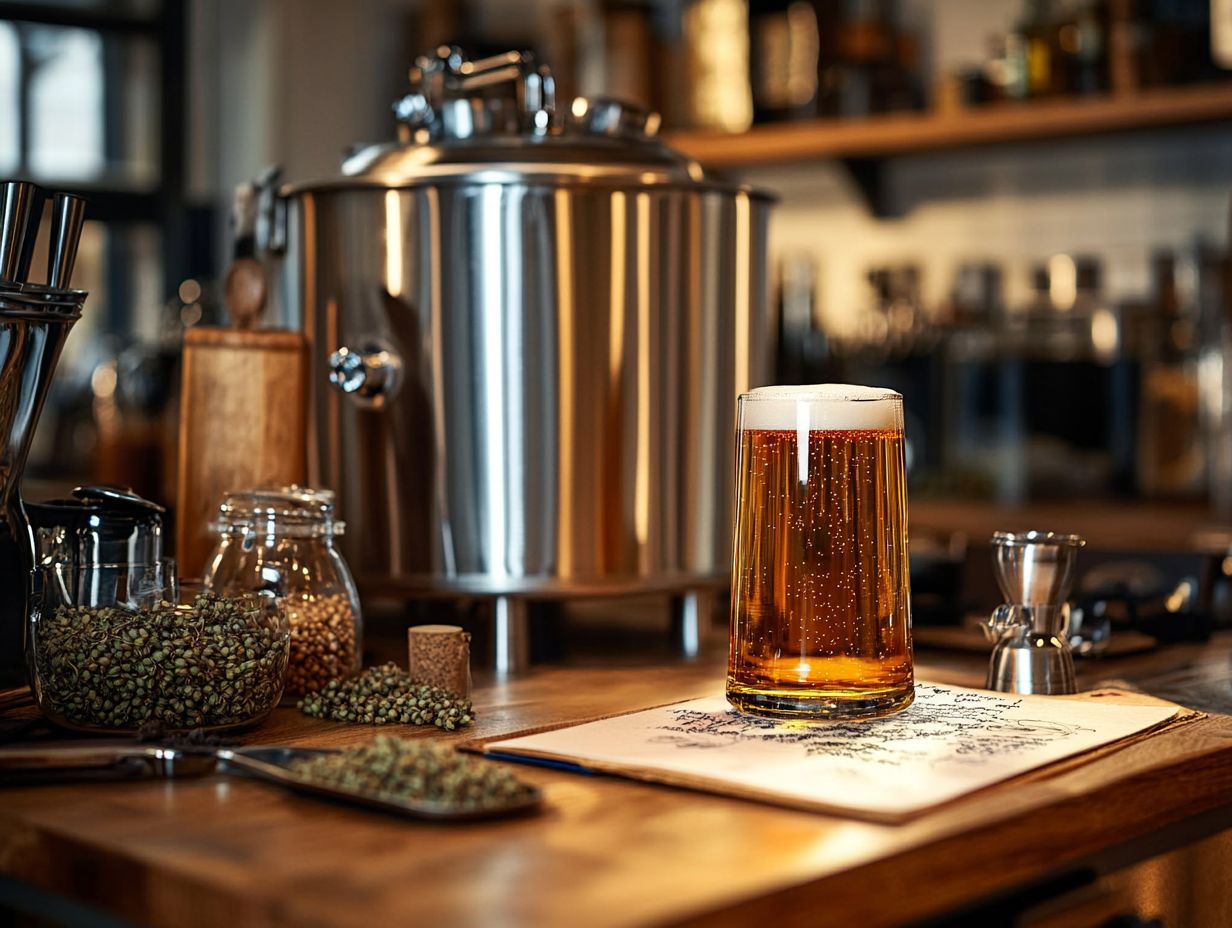
- Home brewing allows for experimenting with different flavors and customizing your beer to your preferences.
- The main ingredients in beer are water, malt, hops, and yeast, but specialty ingredients can be added for unique flavors.
- Controlling fermentation, choosing the right ingredients, and proper aging and storage are key techniques for achieving optimal flavor in home brewing.
What is Home Brewing?
Home brewing is both an art and a science, allowing you to craft your own beer right at home. It opens up a world of possibilities for exploring different brewing techniques, ingredients, and flavor profiles.
Your journey typically begins with selecting high-quality brewing water and malt extract, followed by the meticulous addition of hops and yeast to create brews that are uniquely yours.
As a home brewer, you have the freedom to control essential factors like fermentation temperature, oxygen exposure, and carbonation techniques. This enables you to experiment with a diverse range of beer styles from classic ales to contemporary New England IPAs (NEIPAs).
With the right brewing equipment and techniques, you can experience the sheer satisfaction of creating your own craft beer, tailored to your taste preferences.
Why Brew Beer at Home?
Home brewing opens up exciting opportunities to create your own delicious brews! Brewing beer at home presents a wealth of advantages, enabling you to craft personalized brews that mirror your distinct tastes.
By immersing yourself in the home brewing process, you gain invaluable hands-on experience in quality control. This allows you to experiment with different yeast strains, hops, and spices to achieve the flavor profiles you desire.
Home brewing also builds a sense of community as you share your recipes and techniques with fellow enthusiasts, enriching your overall brewing journey. With a well-equipped brewing kit and a commitment to mastering fermentation control, you can effortlessly create high-quality beer right in the comfort of your own home.
What Are the Benefits of Home Brewing?
Home brewing offers you a wealth of compelling benefits, especially if you’re looking to craft your own unique beer. First and foremost, you ll find significant cost savings compared to purchasing commercial products.
With home brewing, you have the freedom to customize flavors entirely, allowing you to experiment with different malt extracts, hops, and spices until you create a brew that perfectly aligns with your personal taste. This endeavor fosters creativity and innovation, as you refine your brewing techniques and engage with a vibrant community of fellow enthusiasts who share your passion for exceptional beer.
Beyond the financial perks, diving into home brewing can bring you immense personal satisfaction. The journey of transforming raw brewing ingredients into a finished product isn’t just rewarding; it’s an educational experience that deepens your understanding of the intricate science behind brewing.
As you master your skills, you may feel inspired to explore specialty beers, crafting recipes that you won t find in stores. This not only expands your brewing repertoire but also gives you the chance to share your unique creations with friends and fellow enthusiasts, strengthening your connections within the brewing community.
Ultimately, home brewing is about embracing a passion that not only fuels your personal enjoyment but also cultivates a shared love for craft beer. Start brewing today and discover the joy of crafting your own flavors!
What Equipment Do You Need for Home Brewing?
To embark on your home brewing journey, you ll need to gather some essential brewing equipment that will effectively facilitate the brewing process. A complete brewing kit should include a fermentation vessel a container for brewing which is vital for maintaining temperature control during fermentation. You will also need a hydrometer to measure alcohol production accurately.
Don t overlook bottling equipment. Having a capper and a selection of bottles is crucial for the final stages of brewing. Proper cleaning tools are essential for maintaining sanitation and flavor stability. This safeguards against unwanted bacteria or oxygen exposure that can cause off-flavors during brewing.
What Are the Essential Tools for Home Brewing?
Essential tools for your home brewing journey include a fermentation vessel, a pivotal component for the yeast’s fermentation process. An airlock keeps oxygen at bay while allowing carbon dioxide to escape. A thermometer is equally crucial, helping you maintain the optimal fermentation temperature to create a healthy environment for the yeast. This prevents any unwanted off-flavors.
A hydrometer is your secret weapon in brewing! It helps you monitor alcohol production, offering valuable insights as you embark on this brewing adventure. Once you have these foundational elements in place, a brewing kettle becomes necessary for boiling the wort, where you’ll introduce hops and other flavor-enhancing ingredients.
A stirring spoon is also essential, aiding in the thorough mixing of your ingredients to prevent clumping and ensure even heat distribution. Don’t forget about bottles or kegs for storage and serving. A bottle capper or kegging system is critical for proper sealing.
Lastly, a reliable cleaning solution is vital for sanitizing all your equipment. Maintaining cleanliness significantly impacts the final product, ensuring that the brew you create is exceptional.
What Are the Optional Tools for Home Brewing?
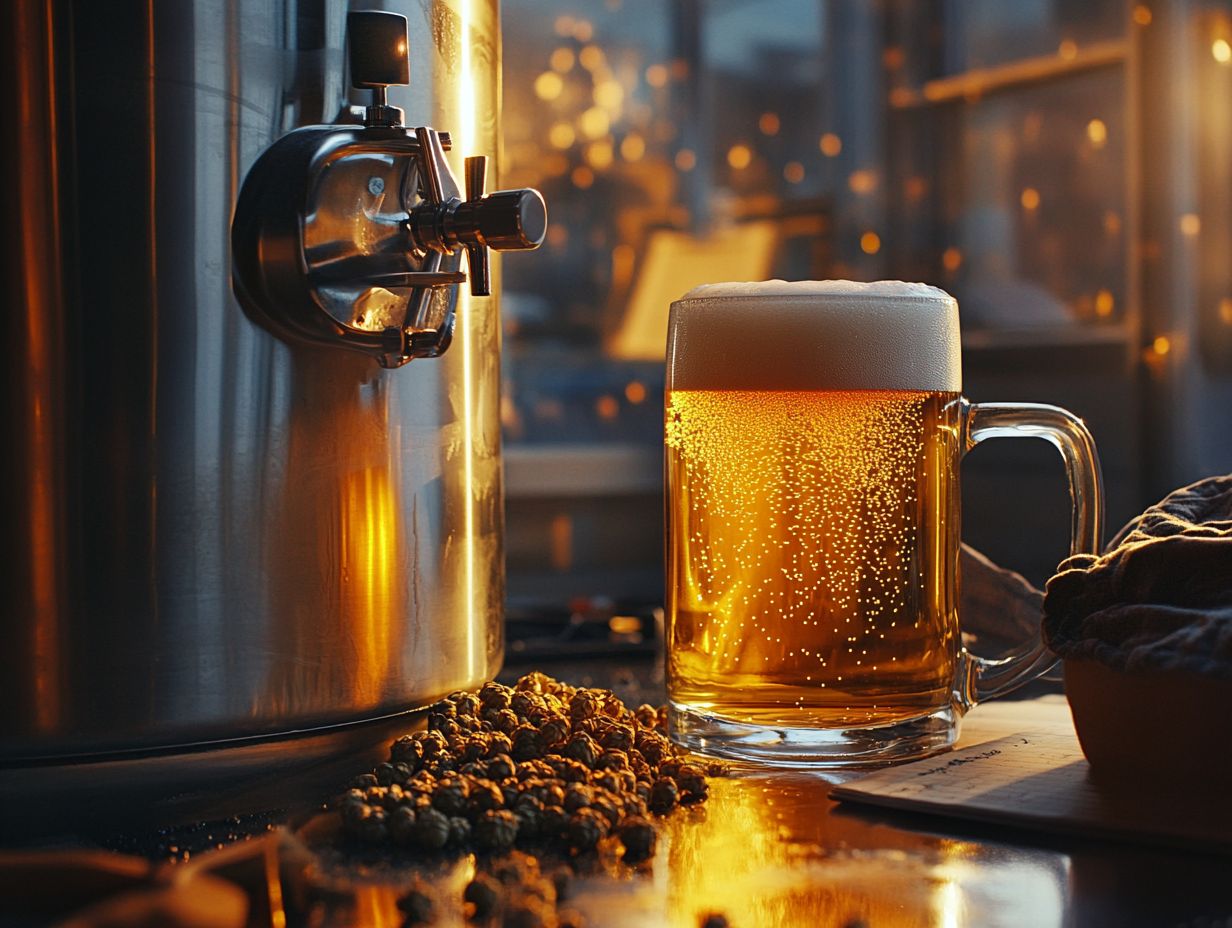
Optional tools for home brewing can elevate your experience and enhance the quality of your craft beer. For instance, a bottling wand makes filling your bottles a breeze. It minimizes the risk of oxygen contact that can spoil your hard work. A good sanitizer is essential for keeping everything clean during the brewing process.
A hop straining bag simplifies adding hops, ensuring you extract optimal flavor without unwanted sediment. Investing in a digital thermometer is a game changer for precise temperature control, vital during both fermentation and mashing.
This level of accuracy can greatly influence your beer’s flavor and consistency. Another invaluable addition to your brewing toolkit is a fermentation chamber. It creates the perfect environment for yeast activity by managing temperature fluctuations that could disrupt your brewing process.
Don t overlook the benefits of a hydrometer or refractometer. These tools allow you to measure specific gravity, enabling you to monitor fermentation progress and calculate alcohol content with precision. Together, these tools will help you craft a final product that is both flavorful and enjoyable.
What Ingredients Are Used in Home Brewing?
The brewing ingredients you choose encompass a variety of essential elements, each playing a crucial role in shaping the final product’s flavor and characteristics.
Malt is your primary source of fermentable sugars, bringing body and depth to your beer. Hops add necessary bitterness and aromatic qualities, striking a perfect balance with the malt’s sweetness. Yeast is vital in the fermentation process, transforming sugars into alcohol and infusing unique flavors into your brew.
Don t overlook the chemistry of your brewing water; it can significantly influence the overall profile of your beer. Paying attention to brewing water chemistry is crucial for optimal results. If you’re feeling adventurous, flavor extracts, spices, and herbs can add even more complexity and uniqueness to your creation.
Ever Wondered What Goes into Brewing Your Favorite Beer?
Let s explore the key ingredients that create the magic!
What Are the Main Ingredients in Beer?
The essential ingredients in beer malt, hops, yeast, and brewing water each play a pivotal role in shaping the beer’s flavor, aroma, and mouthfeel. Using malt extract simplifies the brewing process for beginners while still offering great results.
Malt, typically sourced from barley, is fundamental in producing the fermentable sugars that form the backbone of the beer’s alcohol content. During the mashing process, enzymes break down starches into simpler sugars, providing sweetness and introducing complexity in flavor with a captivating range of colors, from pale gold to deep black.
Hops, the exquisite flowers of the hop plant, contribute the necessary bitterness to balance the sweet malt. They infuse the beer with vibrant floral, citrus, and herbal aromas that elevate its profile. Experimenting with different hop flavors can create unique and exciting brews.
Yeast is often the unsung hero of brewing. Different strains conjure flavors reminiscent of fruits, spices, or even freshly baked bread, imparting unique characteristics to each brew. Proper fermentation control is essential for the best results.
Brewing water, with its varied mineral content, plays a crucial role in flavor extraction and fermentation. It’s an often-overlooked yet vital component in crafting beer with the desired taste and quality.
What Are the Different Types of Hops and How Do They Affect Flavor?
Various types of hops are used in brewing, each contributing distinct flavor profiles to your final beer. Bittering hops are typically added early in the brewing process to deliver the desired bitterness that balances the sweetness of the malt. Later, aroma hops are added during the boiling phase or even during fermentation to infuse fragrant qualities into your brew. Using a hop straining bag helps efficiently separate the hops from the liquid during these stages.
The selection of hops can dramatically influence the overall taste, aroma, and mouthfeel of your beer. Therefore, understanding the characteristics of each variety is essential for achieving the flavor balance you desire in your final product.
For instance, some hops, like Cascade and Citra, are celebrated for their citrusy and fruity notes, lending a refreshing quality to your ales. In contrast, varieties such as Saaz and Hallertau offer herbal and spicy undertones that enhance the character of lagers and traditional European styles. When crafting recipes, consider these flavor profiles.
Hops like Mosaic masterfully combine multiple flavor dimensions from tropical fruits to earthy tones creating complex layers of aroma. By experimenting with different hop combinations, you can craft unique brews that cater to various palates, significantly elevating your beer-making game.
What Are the Different Types of Yeast and How Do They Affect Flavor?
Different types of yeast are pivotal in the brewing process, significantly influencing the flavor and characteristics of your beer. Each yeast strain contributes its own unique taste dimensions and directly impacts the fermentation process, a key aspect of beer brewing.
For example, wild yeast strains like Brettanomyces bring forth funky and earthy notes that are often celebrated in sour beers. Carefully adjusting fermentation temperatures and times enhances or mellows specific flavors and aromas introduced by the yeast. Using a yeast starter improves yeast vitality and fermentation consistency.
The interaction between yeast and other ingredients, such as hops and malt, plays a crucial role in crafting a well-rounded beer. Understanding these nuances allows you, whether a novice or an expert, to customize your brews in exciting and creative ways.
Ready to try brewing your own beer? Gather your ingredients and start experimenting!
What Are the Different Types of Grains and How Do They Affect Flavor?
The variety of grains you choose for brewing plays a crucial role in shaping the flavor, color, and mouthfeel of your beer. Base malts, like pale malt, lay the groundwork by providing the essential sugars needed for fermentation. Meanwhile, specialty grains such as caramel and roasted malts introduce a range of unique flavors, from delightful sweetness to rich chocolate and coffee notes. Using malt extract can also help create a solid base for your brew. To craft balanced and flavorful recipes, understanding the different types of grains and their contributions is essential.
Each grain you use brings its own distinct characteristics. Some enhance the beer s aroma and richness. For example, incorporating wheat can boost the body and create a beautifully hazy appearance, while rye introduces a spicy and peppery complexity, making each sip a more dynamic experience. Your selection of grains can also impact the beer’s foam stability and carbonation, influencing how it interacts with the palate. Understanding brewing water chemistry can further enhance these characteristics.
Master brewers often experiment with various combinations of these ingredients, striving to achieve unique profiles that reflect regional influences or traditional brewing methods. This creative process enriches the diverse and fascinating world of beer.
What Are the Best Techniques for Flavor in Home Brewing?
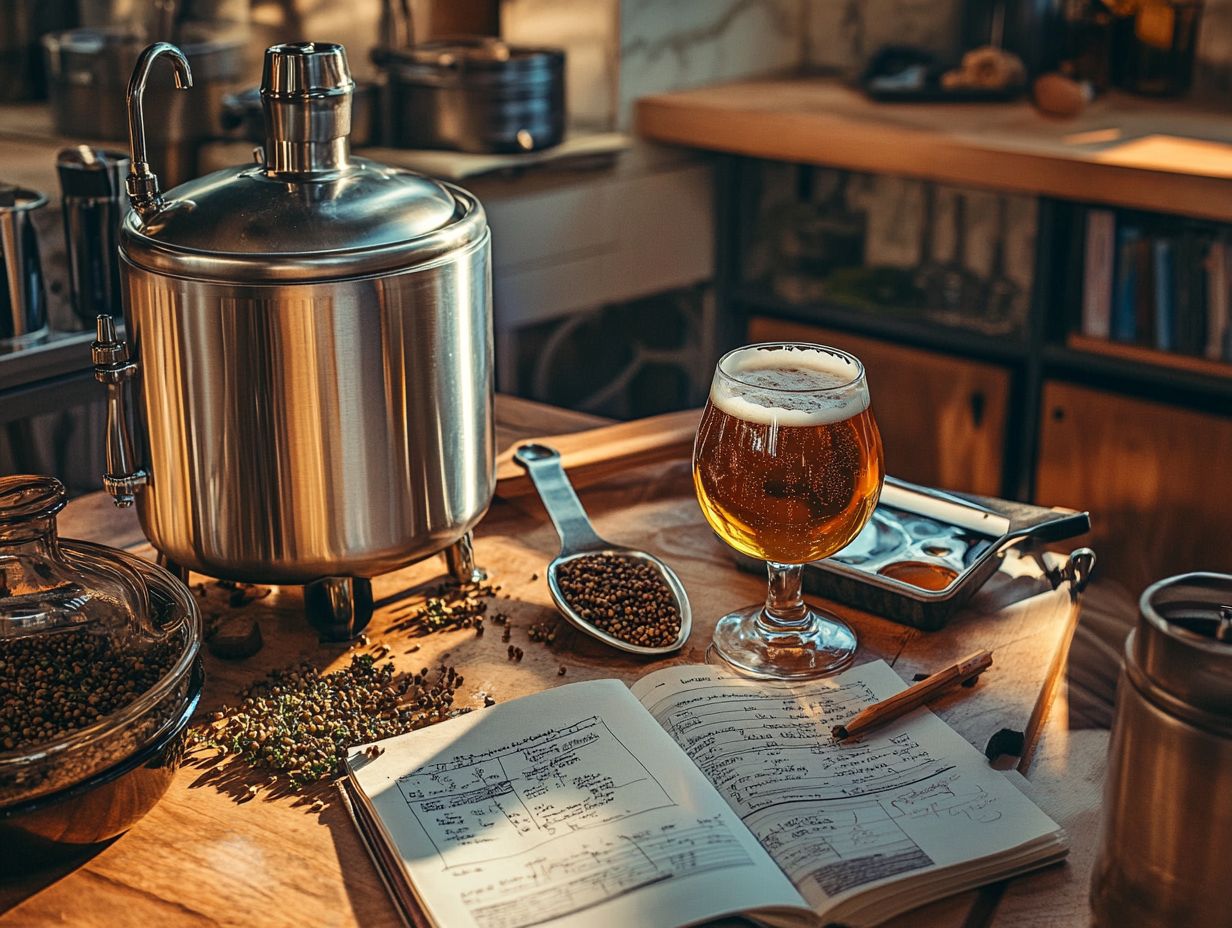
Employing the right techniques for flavor in your home brewing can greatly elevate the quality and uniqueness of your beer. Techniques like dry hopping a method of adding hops during fermentation can amplify hop flavor and aroma. Carefully controlling fermentation temperature helps prevent off-flavors and ensures a clean profile; proper temperature control is key in this process.
Additionally, experimenting with various methods for incorporating spices or flavor extracts can unlock innovative and exciting flavors, transforming your homebrew experience. Using bitter orange peel or coriander during brewing can add unique notes to your beer. Master these techniques to craft truly exceptional beer!
How to Choose the Right Ingredients for Your Desired Flavor?
Choosing the right ingredients is essential for achieving that perfect flavor in your home brew. The balance between malt, hops, and yeast creates a harmonious profile. Understanding the nuances of each ingredient helps in crafting beer with well-rounded flavor.
Each component plays a vital role in the final taste. Malt brings sweetness and body, hops add bitterness and aroma, and yeast influences the fermentation flavors. For example, incorporating citrusy hops like Citra or Amarillo into your IPA brightens it with a refreshing zest that beautifully balances the sweetness of the malt. Conversely, using a diverse range of specialty malts in a porter can create complex layers of chocolate and coffee notes, allowing the hops to take on a supporting role. You can also use brewing sugar to affect the body and alcohol content of your beer.
By thoughtfully selecting and balancing these ingredients, you can craft unique profiles that tantalize the palate and showcase your creativity as a home brewer. This approach provides a strong foundation for effective quality control in your brewing process.
What Are the Different Methods of Adding Hops for Optimal Flavor?
Different methods of adding hops can significantly influence the flavor and aroma of your beer. Techniques like dry hopping, late hopping, and hop bursting are popular among home brewers. Each method has its distinct charm and can be applied to various brewing styles, including the trendy NEIPA.
Dry hopping is a popular method. It imparts a vibrant hop aroma to the beer, giving it a fresh and fragrant profile that’s particularly sought after in IPAs and pale ales.
Late hopping occurs in the last 10 to 15 minutes of the boil. This technique enriches the brew’s flavor by allowing essential oils from hops to retain their aromas, resulting in a more complex taste that tantalizes the palate. Use proper carbonation techniques to maximize these delicious hop flavors!
If you’re feeling adventurous, try hop bursting. By adding a generous amount of hops towards the end of the boil, you create an intense burst of hop flavors while keeping bitterness at bay. By exploring and combining these hop addition methods, you can craft beers that align perfectly with your personal tastes, achieving a profile that is both balanced and thrilling. Using a brewing kit can simplify and streamline this process.
How to Control Fermentation for Optimal Flavor?
Controlling fermentation is crucial for achieving optimal flavor in your home brewing endeavors. Yeast activity and temperature play significant roles in the final product.
Maintaining a consistent fermentation temperature is essential. Any fluctuations can lead to unwanted off flavors or even stalled fermentation. By monitoring yeast health and activity, you can ensure a robust fermentation process, which directly impacts your beer’s flavor profile and clarity.
Mastering fermentation control is a critical skill for anyone serious about brewing at home. Consider utilizing temperature control methods such as fermentation jackets, temperature-controlled fermentation chambers, or simple water baths. These techniques help maintain a steady temperature, creating a healthy environment for yeast and promoting vigorous fermentation.
Avoiding oxygen contact during this phase is crucial to prevent oxidation and off flavors. Regularly assess yeast vitality by checking aspects like plumpness and cell counts. Healthy yeast prevents undesirable flavors and contributes to a clearer brew.
By integrating these best practices into your brewing routine, you can enhance both the quality and consistency of your beer, ensuring that each batch exceeds your expectations. This is a key aspect of fermentation control.
What Are the Different Techniques for Adding Specialty Ingredients for Unique Flavors?
Incorporating specialty ingredients is a brilliant way to craft unique flavors in your home brew. You have a variety of techniques for adding spices, herbs, and flavor extracts.
For example, adding spices during the boil infuses your beer with aromatic qualities that can be enchanting. Introducing them during fermentation offers subtler, more integrated flavors. Understanding the timing and method of incorporating these ingredients is essential to achieving flavor complexity in your brew. A hop straining bag can assist in removing these ingredients after infusion.
Your choice of specialty ingredients can significantly transform the palate. Fresh herbs like basil or thyme introduce delightful herbal and grassy notes that elevate your beer’s overall profile. Flavor extracts provide concentrated bursts of sweetness or citrus, giving you precise control over taste elements.
These techniques are often used in craft beer production to achieve unique and complex flavors. By thoughtfully considering each component and balancing the intensity of the spices with the overall brew, you can elevate your creations to professional levels, captivating the senses with rich layers of flavor and aroma.
Try different hop addition methods today and discover your perfect brew!
How to Properly Age and Store Your Home Brew for Maximum Flavor?
Properly aging and storing your homebrew is essential for maximizing flavor and ensuring stability. Some beers thrive with additional maturation time, while others are best enjoyed in their youthful freshness. Effective temperature control and minimizing oxygen contact are crucial in this process.
Employ carbonation techniques during bottling, such as adding brewing sugar, to enhance flavor over time. This allows those complex notes to unfold beautifully. Store your beer in a cool, dark environment to protect its flavor from light strike and oxidation, which can compromise stability. Using a hop straining bag helps achieve beer clarity and ensures proper sediment separation.
Experts recommend a temperature range between 45 F to 55 F for optimal aging. Warmer temperatures can hasten the chemical reactions that lead to flavor deterioration. By carefully controlling the temperature, you preserve the intended taste profile and facilitate the gradual evolution of your beer s characteristics.
When considering which beers to age, focus on stronger ales with higher alcohol content and rich malt profiles. They tend to develop a rewarding depth of flavor that lighter options may lack. Proper storage methods are vital for maintaining quality; choosing upright versus horizontal positioning is crucial. Also, use brewing equipment that ensures minimal oxygen exposure during bottling.
Store bottles upright to prevent cork breaching or spoiling due to liquid exposure. This technique also aids in the fermentation process by allowing proper yeast settlement and reducing the risk of off flavors.
Frequently Asked Questions
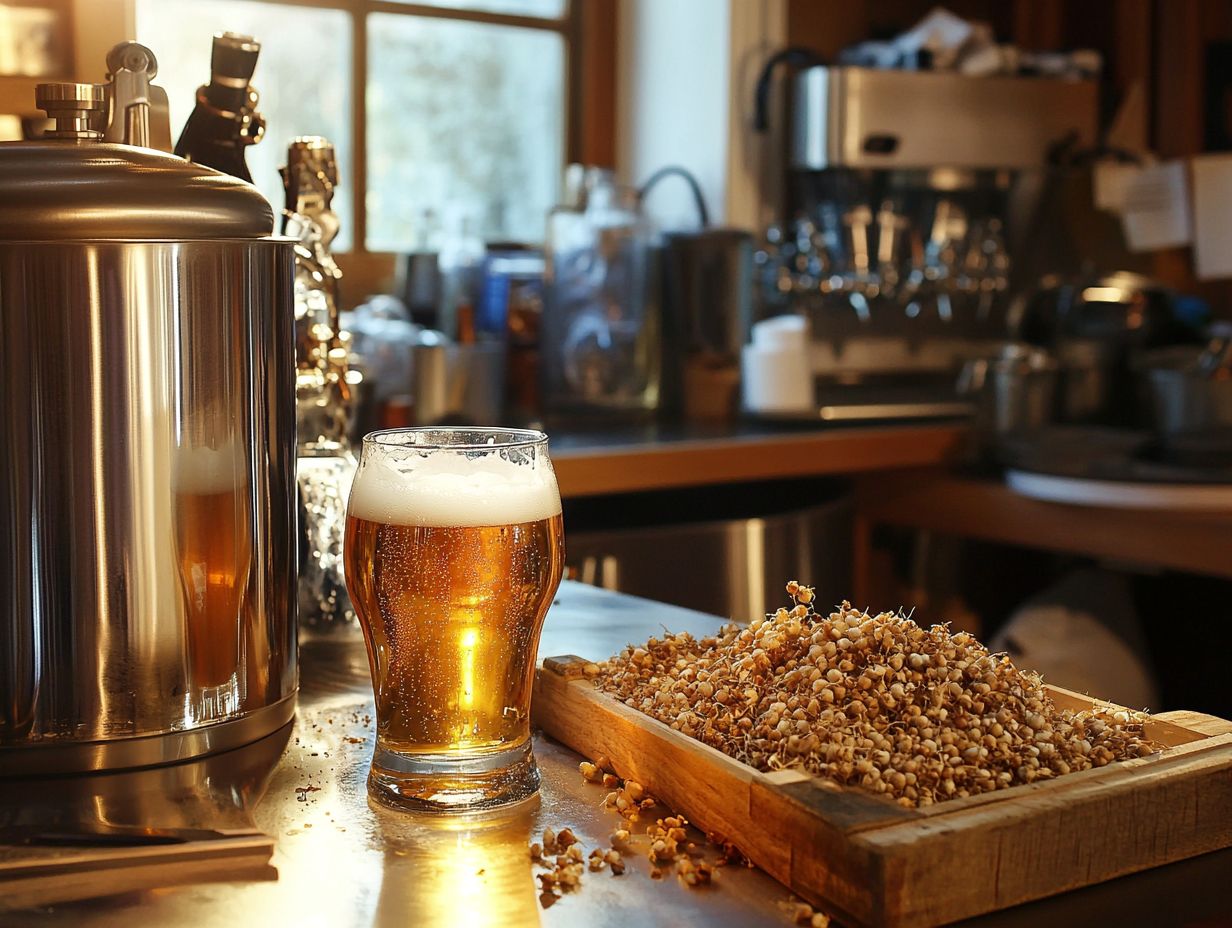
1. What are the best techniques for achieving the most flavorful home-brewed beer?
Some of the best techniques for achieving a flavorful home-brewed beer include:
- Using high-quality, fresh ingredients
- Controlling the brewing process carefully
- Experimenting with different recipes and brewing methods
For instance, dry hopping the process of adding hops to beer after boiling to enhance aroma without adding bitterness can add robust hop flavor and aromas. Adjustments to brewing water chemistry can enhance the overall flavor balance.
2. How important is the quality of ingredients in home brewing?
The quality of ingredients is crucial in home brewing, as it directly affects the flavor of the final product. Using fresh, high-quality ingredients such as malt extract, hops, and brewing water results in a more flavorful and enjoyable beer.
3. Can the brewing process itself impact the flavor of the beer?
Absolutely! The brewing process plays a significant role in the final flavor. Factors such as temperature control, timing, and technique can all affect the flavor profile of the finished product. Proper fermentation temperature and fermentation control also contribute to achieving the desired flavor.
4. What are some popular techniques for adding flavor to home-brewed beer?
Some popular techniques include:
- Dry hopping
- Adding fruit or spices during fermentation
- Barrel-aging
Experimenting with different techniques can lead to unique and delicious flavor combinations. For a unique twist, try adding bitter orange peel or coriander for a zesty flavor, or use flavor extracts for a more concentrated taste.
5. Is it necessary to follow a specific recipe when brewing for the best flavor?
While following a recipe can be helpful, it’s not always necessary. Some of the best home-brewed beers result from experimentation and tweaking recipes to suit personal tastes. Don’t be afraid to get creative and make adjustments to achieve the perfect flavor for you. Consider using a brewing kit or starting with a basic brewing recipe and making it your own.
6. How important is cleanliness in home brewing for flavor?
Cleanliness is crucial in home brewing for many reasons. It helps prevent contamination and off-flavors.
Keeping your equipment and workspace clean is essential for achieving the best flavor in your home-brewed beer. Regularly cleaning and sanitizing all brewing tools helps maintain high quality in your beer.
So, get that sponge out and ensure your brewing area sparkles! Your beer deserves it!

